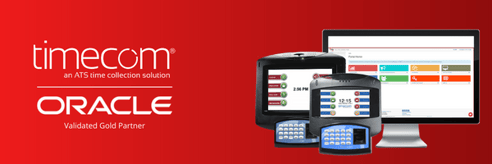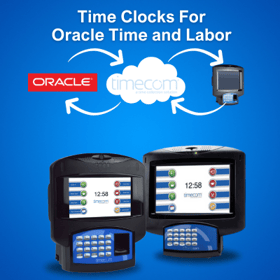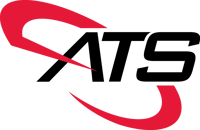Your company works with Oracle Cloud Time and Labor because the workforce management system offers you several money-saving tools. You can add to that tool set by integrating your Oracle time and labor solution with a time and attendance software system.

In this article, we take a closer look at:
- Attendance management policies you need to implement with your time and attendance system to realize its full savings and benefits.
- How to use your time clock system to improve your compliance management, lowering your legal and financial risk.
5 Company Policies You Need for Maximum Savings with Oracle Time and Labor
Good attendance policies save time for HR, payroll, compliance, employees, and managers by reducing administrative tasks. Instead, employees and back-office staff can repurpose that time towards higher value tasks.
Employees have more time for productive work. Back-office teams can focus on strategic responsibilities like optimizing workforce management, development of human capital, and improving legal compliance.
#1 Time Tracking Policies
 Time clocks are the foundation for money-saving time tracking. To achieve maximum benefit from time clocks, your company policy should require workers to clock in and out for every shift and break.
Time clocks are the foundation for money-saving time tracking. To achieve maximum benefit from time clocks, your company policy should require workers to clock in and out for every shift and break.
Your time clock system creates a detailed attendance record for every employee. These are records you can audit to improve attendance and ensure workers aren't skipping or clocking in early from breaks.
In some time and attendance systems, the time clock can prevent workers from clocking in early.
#2 Record-Keeping Policies to Improve Compliance
Managing compliance with labor laws and regulations is difficult. The Department of Labor recognizes this. It has a program to help employers rectify wage and hour violations and avoid costly compliance penalties and litigation.
Yet, you don’t want to rely on governmental benevolence to avoid fines and damages that could be in the millions. To mitigate the risks, your record-keeping policy should require the use of digital solutions that create audit trails. Records that are easier to verify and harder to manipulate provide strong defense during compliance audits.
#3 Scheduling and Absence Management Policies
A scheduling policy includes how managers create schedules and communicate them to employees. Managers use absence management policies to address schedule adherence issues.
Overstaffing and authorizing excessive overtime add significant labor costs. You can avoid these with improved schedule adherence and accurate forecasting tools.
Accurate forecasting allows managers to give workers advance notice of their schedule. Employees scheduled with advance notice are less likely to have last-minute cancellations. The company improves schedule adherence and reduces employee turnover.
 Monitoring schedule adherence and implementing effective absence management policies minimize the high costs of uncontrolled absenteeism.
Monitoring schedule adherence and implementing effective absence management policies minimize the high costs of uncontrolled absenteeism.
Our TimeCom solution for Oracle Time and Labor allows managers to monitor employee schedules and schedule adherence with the data sent from the PeoplePoint time clock.
#4 Data Management Policies
Automating attendance record collection creates accurate data that it shares with Oracle Time and Labor systems.
Your time clock data is the main source of truth for all back-office systems. It ensures data integrity throughout the organization.
#5 Payroll Fraud Avoidance Policies
Fraudulent activities, like buddy punching, clocking in before starting work, or extending hours into overtime, inflate labor costs.
Establish criteria for identifying potential cases of fraud. Set policies to guide how potential fraud is investigated and remediated.
The TimeCom solution helps you detect possible buddy punching by collecting precise clock in and out data. Managers can easily run reports that show punches from the same employees with little time between them. The most effective way to prevent buddy punching is to select the biometric option with the PeoplePoint time clock.
Time & Attendance Tracking with Oracle Time and Labor
A company without an advanced time and attendance tracking system increases its risk of noncompliance with labor laws, regulations or union policies.
Your Oracle Time and Labor system should manage compliance. For example, it should enforce compliance with rules such as overtime limits, rest days, and work hour limits. It should be able to tag overtime hours, so payroll ensures accurate overtime calculations.
#1 Makes Compliance Easier
Automated time tracking helps improve compliance with time and wage requirements by:
- Giving managers more time for reviewing and approving time.
- Simplifying gross pay calculations.
- Allowing employees to see their worked hours and upcoming schedules, which minimizes overscheduling.
- Enabling managers and human resources to compare scheduled hours against worked hours, so they can correct errors and enter missing time.
#2 Immediate Resolution of Attendance Problems
The time and attendance system (Oracle Time and Labor) should give managers daily reports on attendance record issues, like anomalies.
- Punches late to shift or early to leave.
- Unscheduled absences.
- No breaks taken, or breaks were too short or too long.
- Punches in that have no corresponding punch out, and vice versa.
Managers can use this report to correct attendance errors or remediate behavioral issues quickly.
It also helps catch potential issues in payroll processing since managers have more time to review and approve payroll before it runs. With more time, managers do a better job of finding errors. They have time to adjust pay codes, add comments, or make adjustments to the time data before payroll runs.
#3 Flexible Scheduling
By integrating your time and attendance software with Oracle Time and Labor, you streamline your scheduling process. It helps managers, compliance, and workforce management oversee shift patterns, avoid overlapping schedules, and improve schedule forecasting.
For example, employees can submit time off requests at the time clock in the TimeCom solution. The automated process speeds up time-off requests, getting that information into Oracle and available when new schedules are being made.
Smart Time and Attendance Management Improves Productivity
Your company will also benefit financially because of the improved productivity.
Employees appreciate the improvements made in scheduling and the consistently accurate payroll system. Managers and compliance teams can manage their responsibilities more easily and with less stress. The result is a more productive workforce.

To learn more about time and attendance and begin creating an Employee Attendance Policy that sticks, download our free eBook The Step-By-Step Guide to Minimizing Absenteeism. Or get in contact with a team member by clicking the button below.






